Content
- What is Direct Massage?
- Why and when is it held?
- What is the difference from indirect?
- Precautionary measures
- Technique for performing direct heart massage
- How often do you manage to save?
- What's the prognosis?
- Video about heart massage
Cardiac arrest is one of the most serious complications in cardiology, traumatology and resuscitation. Implementation of direct and chest compressions in combination with mechanical ventilation is a complex of resuscitation measures aimed at restoring the activity of the heart muscle and eliminating the threat to the life of the resuscitated person.
What is Direct Massage?
Direct heart massage is an activity aimed at restoring myocardial function. It is carried out with direct access to the heart muscle.
Myocardial massage is included in the complex of resuscitation measures in the following cases:
- cardiac arrest;
- bradycardia (below 20 beats per minute);
- atrioventricular block;
- uncontrolled fibrillation.
When providing medical care, methods of direct and indirect massage are used.
Their differences:
- Direct cardiac massage is a procedure that is most often used during thoracic or abdominal operations in the peritoneal region (open method). Less commonly, through an incision between the 4th and 5th ribs of the chest (transthoracic). This manipulation is performed by an experienced surgeon.
- Indirect or closed (outdoor). It is carried out by rhythmic pressure on the victim's chest in the anteroposterior direction, that is, from the sternum to the spine. Help can be provided by anyone, even without medical education.
The mechanism of action is based on rhythmic compression of the heart (90-110 times per minute) by direct or indirect method. The effectiveness of the procedure is increased by artificial ventilation of the lungs, carried out simultaneously with the massage. These measures lead to the restoration of coronary circulation, and then to the emergence of spontaneous myocardial activity.
The first mention of heart massage dates back to the 19th century. They can be found in the works of A. Nikitin (1846) and N. AND. Pirogov (1866). They recommended using a chest concussion or light blows to the sternum to revive the victim. European doctors Howard, Boehm, Mikkwitz worked on the issue of reviving people through rhythmic compression of the chest. In 1860 g. Howard described the technique of indirect massage.
In 1883 doctor F. Koenig and his assistant Maass published a study on the restoration of independent coronary activity through rhythmic pressure on the sternum 30-40 times per minute. In the medical literature, this is called the "König-Maass method".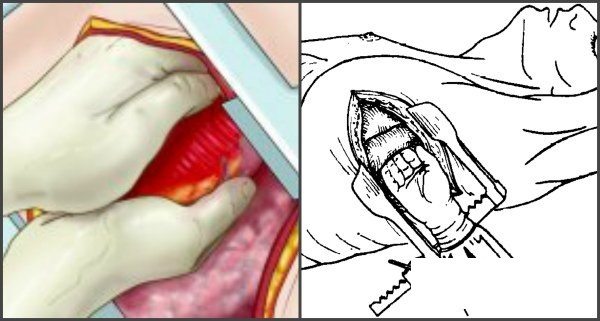
By the middle of the twentieth century. the clinical practice of myocardial massage was developed. Direct cardiac massage has become famous for the development of thoracic surgery. And indirect, together with mechanical ventilation through the mouth-to-mouth method, became available for medicine after the work of Cowenhoven, Jude, Knickerbocker in 1960. In the USSR, this method of resuscitation was revived by the team led by V. BUT. Negovsky in 1962
Why and when is it held?
The indications for the procedure are:
- lack of heartbeats (asystole);
- reduction in the efficiency of blood flow against the background of ventricular fibrillation, sharp bradycardia.
Signs of a lack of heart function are:
- there is no pulse;
- mydriasis of the pupils;
- absence or presence of an agonal breathing pattern;
- loss of consciousness;
- muscle atony;
- cyanosis of the skin.
When providing medical care, it is important to remember that resuscitation measures begin as early as possible, from the moment the blood circulation stops. Since after 5 min. oxygen starvation in the brain cells, irreversible changes begin, up to their death.
Direct heart massage is done in case of:
- cardiac arrest during chest surgery;
- multiple injuries to the ribs, sternum and spine. This poses a threat of damage to the pericardium or lung;
- penetrating wound in the region of the heart;
- cardiac tamponade;
- tense pneumothorax;
- open trauma to internal organs;
- deformation of the chest, which makes it difficult to perform indirect massage;
- hypothermia of the patient;
- air embolism or pulmonary embolism;
- ineffectiveness of indirect massage for 5-7 minutes.
It must be remembered that resuscitation is not performed if there are contraindications.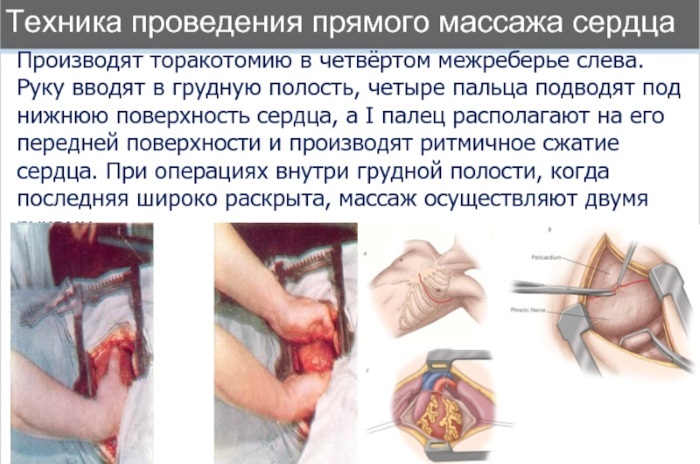
This could be:
- the presence of injuries incompatible with life of the brain and internal organs;
- terminal stage of cancer or other incurable disease;
- prolonged absence of blood circulation in the victim (more than 10 minutes) before the start of resuscitation measures.
Direct heart massage is a surgical intervention that is performed only in a hospital. At home, ambulance employees, doctors of non-core specialties (therapists) are prohibited from doing it.
What is the difference from indirect?
Different types of massage require different conditions for its implementation:
| For direct massage | For indirect massage | |
| The integrity of the chest (abdominal) cavity. | Violated or an additional incision is made. | No |
| The qualifications of the person performing the massage. | It is performed by an experienced thoracic or cardiac surgeon. | Any person who happens to be nearby. |
| The presence of complications. | Rupture of the myocardium, ventricles, rupture of heart implants, damage to arteries, phrenic nerve. | Fracture of ribs, sternum with strong pressure, rupture of the liver, injury to the lung tissue. |
| Requirements for conducting. | In the hospital, in the operating room. | Anywhere, on a hard surface. |
In case of cardiac arrest at home, in a traffic accident, in the absence of qualified medical care, the victim is given an indirect heart massage. During this technique, intrapleural pressure is increased by squeezing the chest.
There is an indirect effect on the heart muscle, lung tissue. As a result, coronary circulation is stimulated, hypoxia is reduced, and mechanical stimulation reflexively restores the activity of the myocardium.
Technique and algorithm:
- The patient must be laid on a flat, hard surface. Free his airways from vomit and foreign objects, tilt his head back and extend the lower jaw. Raise your legs a little, placing a roller of clothes under them.
- Before the procedure, you can apply a precordial punch to the sternum from a height of 30 cm. This is sometimes enough to resume the work of the heart.
- The person who provides assistance is located to the left of the patient, puts his hands (one on top of the other) on the lower third of the victim's sternum, perpendicular to his body. You cannot bend your arms at the elbows. The pressure is carried out with the whole body. For a child, manipulations are done with one hand, and for children under 1 year old - with two fingers.
- Compression of the chest is carried out with strong rhythmic pressure so that the sternum is displaced by 3-6 cm in the anteroposterior direction. Frequency - 100-120 / min. The first press should be slow and smooth to assess the compliance of the chest and prevent rib fractures.
- There must be decompression - complete expansion of the chest after compression.
- The heart is compressed by the sternum and ribs on one side, and by the spine on the other. There is a pushing of blood from the ventricles into the vessels.
- If resuscitation is done by 1 person, then after 30 pressing on the sternum, 2-3 exhalation into the victim's respiratory system should be done “Mouth to mouth” or “mouth to nose” (with the “mouth to mouth” method, cover the patient's mouth with a handkerchief, napkin or gauze, and hold his nose with the other hand). With the joint action of two rescuers: for 10-15 clicks - 1-2 exhalation. Artificial respiration is a prerequisite for resuscitation.
- Additionally, drugs are administered: adrenaline, mezaton, calcium chloride or gluconate. They stimulate the heart.
An indirect cardiac massage compensates for 50% of the normal blood flow. Therefore, resuscitation measures cannot be interrupted until the victim's normal life is restored.
The prognosis is favorable if the victim is assisted in the first 5-7 minutes. after cardiac arrest, in the absence of brain damage and extensive trauma to internal organs.
The heart massage is stopped if the victim has a pulse in the carotid arteries, breathing has returned to normal, the reaction of the pupils to light, and the blood pressure is above 60 mm Hg. Art., consciousness began to return.
Precautionary measures
Direct cardiac massage involves the correct implementation of the technique to reduce the risk of possible complications.
It can be:
- detachment of implanted valve prostheses;
- rupture of the ventricles, atria;
- myocardial damage due to too much pressure or improper position of the surgeon's hand;
- injury to the pericardial-phrenic artery. Leads to profuse bleeding, impaired diaphragmatic circulation;
- damage to the phrenic nerve when opening the chest cavity, which leads to paralysis of the dome of the diaphragm.
After the provision of resuscitation measures, the following are noted: wound infection with subsequent inflammation; rhythm disturbance in the form of paroxysmal tachycardia, atrial fibrillation.
Technique for performing direct heart massage
Direct cardiac massage is a procedure performed by an experienced surgeon. This requires full access to the heart for direct massage.
The sequence of actions of the surgeon:
- It is necessary to start performing massage immediately after detecting a violation in the work of the myocardium. The lack of normal blood supply has a negative effect on the activity of the brain, which can subsequently lead to paralysis, paresis, loss of some functions (speech, writing, and others).
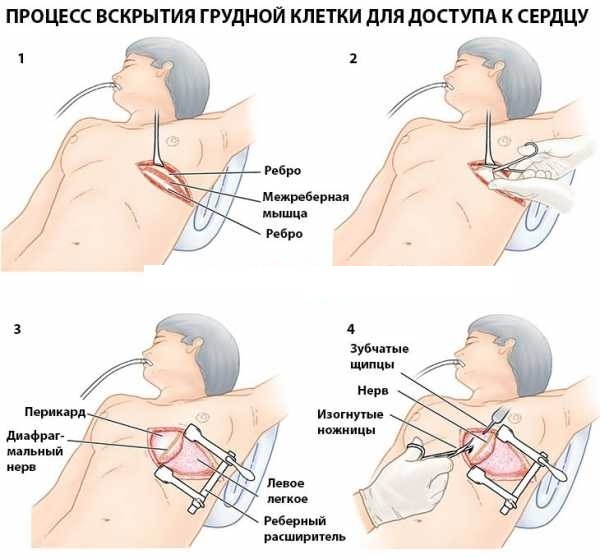
- If the stop occurred during an operation on the chest cavity, and the myocardium is closed: the chest is opened, the ribs are moved apart. Or an incision is made in 4 or 5 intercostal space with an indent of 2 cm from the edge of the sternum (transthoracic method). For abdominal surgery, access is required from the side of the xiphoid process.
- For the massage, the surgeon's right hand is inserted into the chest cavity. In this case, the apex of the heart lies in the palm of the doctor, the thumb is on the front surface of the heart muscle, and the rest are on the back.
- The myocardium contracts rhythmically. Contraction rate up to 110 / min. This provides nearly 90% of the oxygen demand of the brain. The main pressure is exerted on the ventricles towards the incoming vessels. The massage can be done with two hands: one presses the heart to the ribs, the other fixes the sternum.
- The massage is performed continuously with simultaneous ventilation of the pulmonary system.
- For additional stimulation of cardiac activity (with asystole), solutions of ephedrine, adrenaline, calcium chloride are administered. To replenish blood loss: erythrocyte mass, plasma, plasma substitutes.
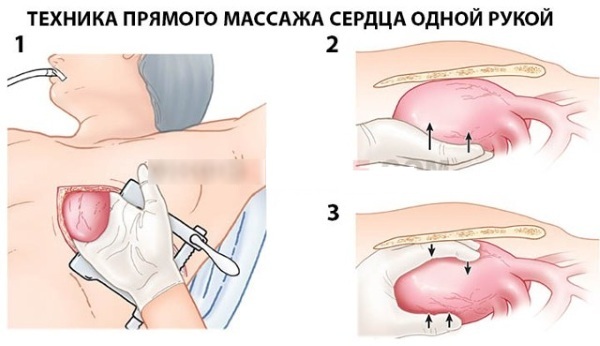
Direct heart massage
After the end of the operation, drainage of the pleural cavity, plain radiography, monitoring of the patient's condition are performed.
In 25-50% of cases, cardiac arrest during surgery occurs due to ventricular fibrillation. The second most common cause is myocardial tamponade, massive bleeding.
If the arrest occurs against the background of ventricular fibrillation, direct massage is first performed to improve coronary circulation and eliminate hypoxia, and then defibrillation. Animal tests have shown that this order of resuscitation is more rational.
The massaged heart becomes firmer, more elastic, and becomes pink in color. After using a defibrillator, an independent heart rate is immediately restored, which leads to an increase in blood pressure. It is most optimal to influence the heart with a strong short-term electric current impulse.
Defibrillation is carried out with special electrodes in the form of spoons. After the normalization of the heart rate, they are carefully removed, since careless actions can damage the myocardium.
Resuscitation measures continue until the restoration of independent work of the heart muscle, an increase in systolic pressure above 60 mm Hg. Art., the return of the normal color of the skin. More often, cardiac arrest occurs during surgery, when the patient is in a state of deep anesthesia, and the reaction of the pupils to light, the patient's spontaneous breathing may not be. Control is carried out visually and using a monitor.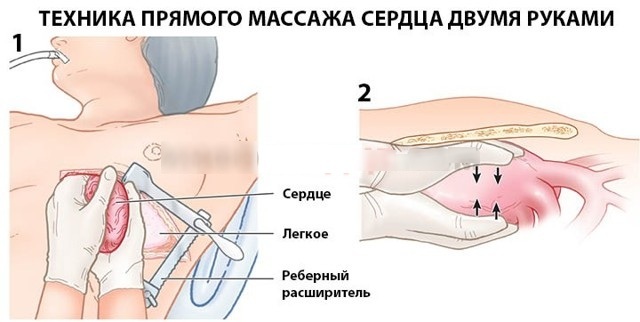
Any impact ceases from the moment of establishing the patient's biological death (the presence of irrefutable signs). This happens no earlier than after 30-40 minutes. after complete cardiac arrest.
How often do you manage to save?
The development of modern medicine, the emergence of new operating techniques, contributes to the fact that the effectiveness of direct cardiac massage increases: in 2002. successful resuscitation was in 46% of patients, in 2011 in 82%. (Massachusetts Hospital statistics).
According to R. McGrath patient survival rate is 39%. More than half of them die within 1 day after resuscitation. Based on clinical studies, a hypothesis was formulated that mortality depends on from the degree of myocardial dysfunction, which is damaged during circulatory disorders and defibrillation.
According to clinical statistics, the survival rate after direct exposure is higher than after indirect exposure. Direct compression of the heart muscle provides better blood supply to the coronary arteries, allowing faster self-contraction of the myocardium. With indirect - the action is carried out indirectly through the sternum and lungs.
Direct heart massage is, first of all, the correct technology for its implementation, which is known to thoracic and cardiac surgeons. The intervention of doctors of other specialties leads to complications and death of the patient. In addition, the cause of cardiac arrest, concomitant pathology of internal organs should be taken into account.
What's the prognosis?
After direct massage of the heart muscle, the prognosis depends on many reasons.
The most significant are:
- the cause of cardiac arrest;
- the patient's diagnosis;
- the presence of concomitant diseases;
- the duration of the absence of normal blood circulation;
- stages of postresuscitation disease;
- experience and qualifications of the surgeon, the correct conduct of resuscitation measures.
In the medical literature, there are few statistics on the survival of patients after direct cardiac massage, since such resuscitation actions are rare in clinical practice. Also little known are the consequences, primary and secondary complications.
Heart massage, both direct and indirect, is able to restore the independent work of the myocardium, and this can save the life and health of the patient. It is important to remember that the survivor's survival depends on the speed of medical care, the correct technique, differences in the method of application, and the presence of complications.
Video about heart massage
Cardiopulmonary resuscitation:



